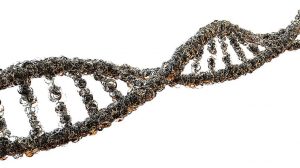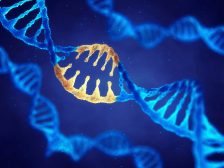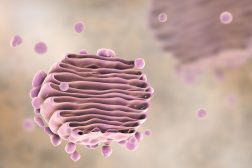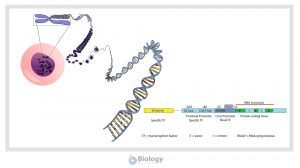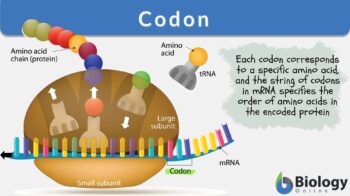
Codon
n., plural: codons
[ˈkəʊdɒn]
Definition: Series of nucleotides that specify a specific amino acid during translation (a step in protein synthesis)
Table of Contents
What does codon mean? A codon, in biology, is the basic genetic unit of life that acts as the template for the amino acid synthesis required for protein expression. All the information required for life is stored in the genes and protein expression is the modality through which information encoded on the genes is expressed. Thus, the codon acts as an essential genetic unit of life.
Do you know why mRNA and not a DNA fragment carries the code for protein synthesis? Our Expert shares views in the Forum: What does mRNA do in protein synthesis? Come and share your thoughts!
Codon Definition
What are codons? A codon is a specific sequence of nucleotides on an mRNA that corresponds to a specific amino acid or to a stop signal during protein translation. A nucleotide, in turn, is made up of a nucleobase (or simply, base), a sugar, and a phosphate group.
How many nucleotides make up a codon? Well, a sequence of three nucleotides constitutes a codon or we can say trinucleotide sequence makes a codon on mRNA. The basic nucleobases of RNA nucleotides are:
Therefore, how many bases are in a codon? Because a codon consists of three nucleotides, a codon would, then, have three bases. So a typical example of a genetic codon would be a triplet code, e.g., adenine-uracil-guanine (AUG), uracil-cytosine-cytosine (UCC), uracil-guanine-adenine (UGA), etc., that code for a specific amino acid.
What does codon code for? Because the collection of codons on mRNA forms the genetic code, a codon is the smallest unit of genetic code. In simple terms, each codon actually encrypts a specific amino acid. It may also code for a signal to stop or start the process of protein synthesis in a cell. See Figure 1.

A codon is the amino acid coding unit in DNA or messenger RNA (mRNA). The string of codons in the mRNA specifies the order of amino acids in the encoded protein. Apart from amino acids, there are also codons that specify start/stop signals. Each codon consists of a set of three adjacent nucleotides (also called triplets) in mRNA that base-pair with the three bases of the corresponding anticodon of a tRNA molecule that carries a particular amino acid. The ribosome, where protein synthesis occurs, has binding sites where the tRNAs can match up with their corresponding codons in the mRNA. Synonym: coding triplet. Compare: anticodon.Examples of codons:
Properties of Genetic Code
Genetic codes are the basic connection between the sequence of the amino acids in proteins and the nucleotide sequence of RNA or DNA. Thorough investigations have established few basic properties of the genetic codes.
- Genetic code is a triplet code. Each amino acid is encoded by a sequence of three nucleotides, i.e., a codon or sequence of three bases decode to form an amino acid.
- Each code is devoid of any punctuation, meaning each genetic code is read sequentially.
- A genetic code is non-overlapping. In a sequence of codons, for example, ABCDEFGHI, “ABC” will code for the first amino acid, followed by “DEF” for the second amino acid and “GHI” for the subsequent amino acid. Thus, each amino acid is coded by a non-overlapping genetic code.
- Genetic code is degenerate. One amino acid is coded by more than one codon. Codons that code for the same amino acid are known as “synonyms”. For eg: UGU and UGC are synonyms for cysteine; both code for cysteine.
Want to hear more about the genetic code? Join us in the Forum: What does mRNA do in protein synthesis? Let’s talk about it!
Function of Codon
What is the function of the codons? To understand this, we should know about translation. A basic understanding of this cellular process will explain the connection between a codon and an amino acid. Each DNA has a number of genes that carry out essential functions of life by generating the requisite protein molecules. Thus, the expression of genes entails the production of the encoded protein through it.
The process of protein synthesis is essentially carried out in two steps. They are transcription and translation.
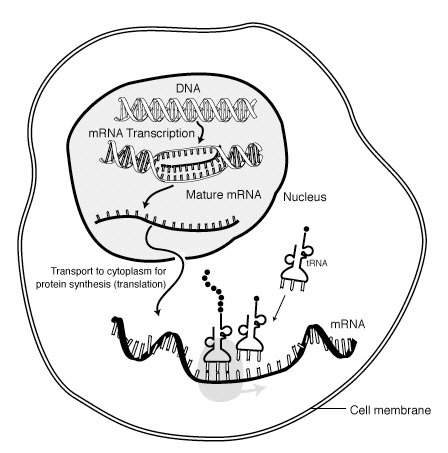
Transcription
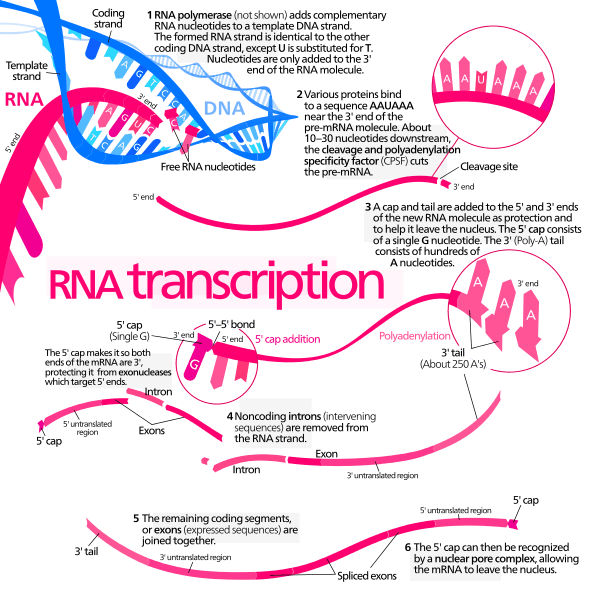
Transcription is the first step in protein synthesis wherein DNA acts as a template for the generation of mRNA or messenger RNA. During this process, the information encoded in DNA for each protein is transferred to mRNA. DNA functions as a template for complementary base-pairing to transfer information of protein expression to mRNA.
Translation
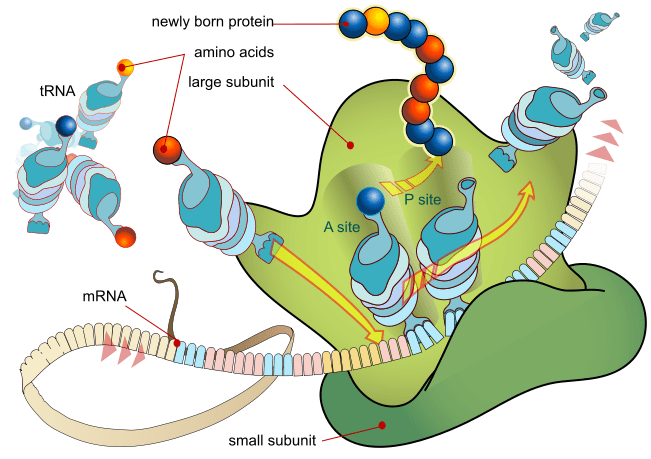
An mRNA is a single-stranded nucleic acid. The genetic information it carries is acquired from the DNA molecule via transcription. The genetic code includes codons that will be translated into proteins. Thus, codons and amino acids are closely related to each other and are essential for all life processes.
Anticodon, too, consists of trinucleotide sequences; however, they are found on the transfer RNA (tRNA). Anticodons are nucleotide sequences that are complementary to the base sequences on the mRNA. The presence of anticodons on tRNA ensures that suitable amino acid is introduced into the protein structure. We now have clarity that codons are present on the mRNA while anti-codons are present on the tRNA.
Watch this video showing the process of protein synthesis.
All the genetic information is encrypted in the DNA molecule. The genetic information is, then, transferred to mRNA as codons. The codons are eventually expressed as protein. Thus, the basic function of the codon is to encode the amino acid which eventually forms the proteins.
Would you like to know more about the role of mRNA in protein synthesis? Come and join us in the Forum: What does mRNA do in protein synthesis? Let’s figure it out!
Types of Codons
There are basically two types of codons: the signal codons and the non-signal codons. The signal codons are the codons that provide the signal during the translation process; these signal codons can be further classified as start codons (i.e., the codons that encode the signal for initiating the protein translation, e.g. AUG) and stop codons (i.e., the codons that terminate the protein translation process are known as stop codons, e.g., UAG, UAA, and UGA). The non-signal codons are the codons that are primarily for translation, typically after translating the start codon.
Another way to classify codons is if they code for an amino acid or not. Those that code for a particular amino acid is called a sense codon whereas those that do not code for an amino acid are called a non-sense codon (e.g. stop codons).
Going further, we now need to understand how many codons there are in the genetic code. There are a total of 64 codons, i.e., 4X4X4 present. And so, how many different codons code for amino acids? Out of the 64 codons, 61 codons encode for the 20 amino acids, and the rest codes for codon signals. Isn’t that surprising? The 61 codons code for only twenty amino acids and not 61! Well, that’s because if you will remember the genetic code is degenerate. That means there are amino acids that are specified by more than one codon. How is that possible? Let’s read the next section below.
Translation of Nucleotides to Amino Acid
How does the tRNA start translating?
The tRNA should be able to detect a reading frame. A Reading Frame would consist of a sequence of nucleotide triplets (sense codons) for translation. The tRNA would recognize a reading frame for translation if a start codon precedes the sense codons.
In eukaryotes, the most common Start codon is the AUG codon. It specifically codes for the amino acid, methionine (Met). In prokaryotes, it is also the common start codon but it codes for formyl methionine (fMet). Thus, many proteins will therefore begin with Met (in eukaryotes) or fMet (in prokaryotes).
Other start codons are also possible albeit rare. An example of a non-AUG Start codon is the CUG codon that codes for leucine (Leu). In prokaryotes, the start codons may be GUG or UUG and in the eukaryotic mitochondrial genome, the start codons may be AUA or AUU.
If that’s how the tRNA starts translating, how does the tRNA know when to stop translating?
There are three specific codons that signal the termination of the protein translation. They are UAG, UAA, and UGA. These codons that signal the stop of the translation are referred to as the Stop codons (or non-sense codons). They signal the release of the protein formed over the mRNA template. Thus, these stop codons are also known as the releasing codons. This termination of the protein translation that subsequently causes the release of the protein is attributed to the absence of the complementary anticodons on the tRNA. The role of the start and stop codons is diagrammatically represented in Figure 5.
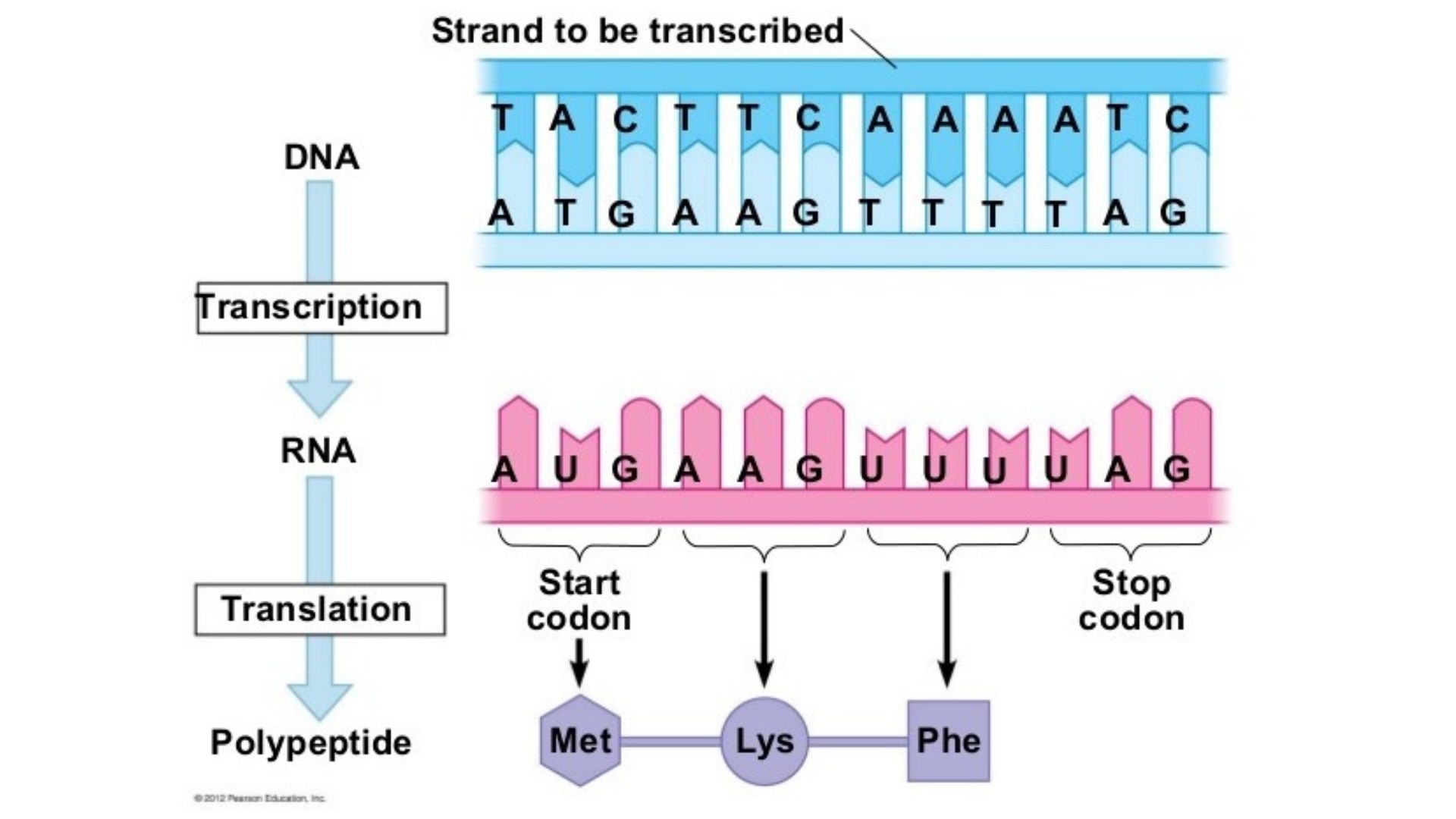
The sequence of the codon between the start codon and the stop codon in the coding region is known as the open reading frame. Start codons along with neighboring initiating factors initiate the protein translation process.
Out of 64 codons, there are three codons that code for the termination of the protein translation; the rest of the 61 codons are expressed as proteins. All the 64 codons have been deciphered to their respective amino acids and are systematically represented in the amino acid codon table. To determine and standardize the representation of these 61 codes to the corresponding amino acid, a codon table or amino acid codon table was developed. The standard amino acid codons are represented in the table below (Figure).
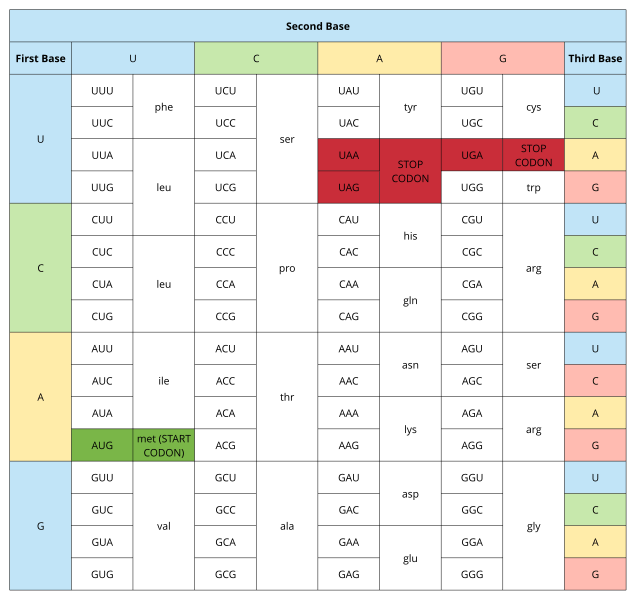
Now let’s understand how to decipher or read this codon table. The most important point to remember is that the whole codon table is based on the UCAG sequence of the nucleotides in each axis. The Y-axis represents the first nucleotide in the codon, while the X-axis represents the second nucleotide of the codon. Both Y- and X-axis forms 12 quadrants of the sequence UCAG. The Z-axis represents the third nucleotide wherein each of the 12 quadrants is first subdivided as per the UCAG sequence.
Now let’s see. What does the UCG codon will encode for?
First, look for U (first nucleotide) on the Y-axis, and then, C (second nucleotide) on the X-axis.
As a result, we will reach the first row and second column. Now on this quadrant, the third nucleotide will determine the position of the codon out of the four quadrants.
Thus, we will reach to 4th quadrant of the first row, the second column, which encodes the amino acid serine according to the codon table. These steps are represented diagrammatically in the figure below.
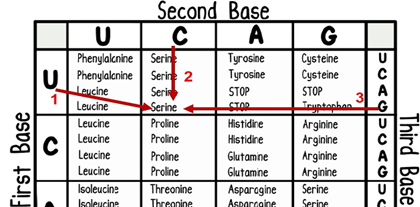
The elucidation of amino acids using codon sequencing can also be done using a codon chart or the amino acid code chart (Figure 8).
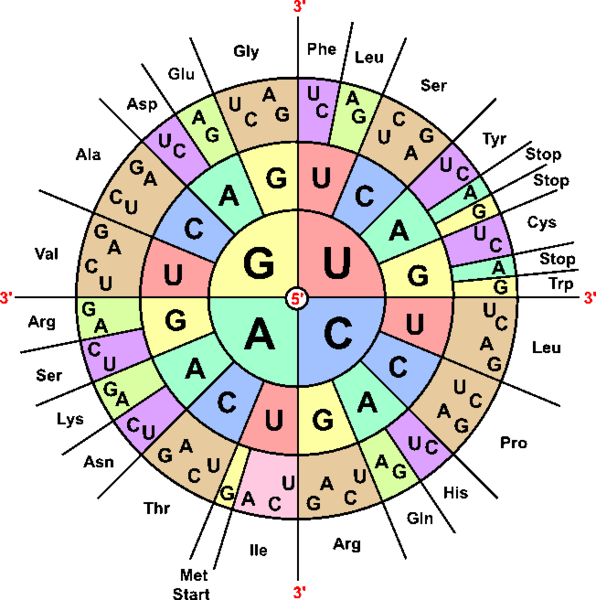
In the codon chart, the innermost circle represents the first nucleotide. The second inner circle represents the second nucleotide while the outermost circle represents the third nucleotide in a codon.
Now, to decipher the amino acid from the codon, one has to move from the innermost circle to the outermost circle, thus decoding the amino acid from the codon.
Similar to the RNA codon chart/table, there is a DNA codon table as well. The only difference between RNA and DNA nucleotide base sequence is that in DNA, in place of uracil (U), thiamine (T) is present. Accordingly, the DNA codon table changes from U to T. The reading or the amino acid elucidation pattern for the DNA codon table remains the same. Even though uracil is replaced by thiamine in the DNA base sequence, the coded amino acid remains the same. This is an important point which one should remember to avoid any confusion between a DNA codon table and an RNA codon table.
In the past, genetic codes were considered to be universal; however, studies have found a slight alteration in genetic code for mitochondria and certain ciliates. In human mitochondria, the UGA codon is not decoded as a stop signal. Contrarily, UGA in human mitochondria codes for tryptophan amino acid. In mitochondria, AGA and AGG are stop signals; outside mitochondria, AGA and AGG code for arginine. Similarly, the AUA codon in mitochondria codes for methionine instead of isoleucine. Thus, ample examples exist that prove that mitochondrial genetic code differs from the rest of the cell. The difference in genetic code for mitochondria are represented in the table below.
Table 1: Unique mitochondrial codons and their corresponding amino acid/stop signal. (Source)
| Table: | ||
|---|---|---|
| Codon | Standard code | Mitochondrial code |
| UGA | Stop | Tryptophan |
| UGG | Tryptophan | Tryptophan |
| AUA | Isoleucine | Methionine |
| AUG | Methionine | Methionine |
| AGA | Arginine | Stop |
| AGG | Arginine | Stop |
Similar to mitochondria, in certain ciliates, both UAA and UAG codons encode for amino acids and do not code for the stop signals. In such ciliates, the termination signal or the stop codon is encoded by the UGA codon. Thus, genetic codes are now not considered to be universal. Earlier, it was considered that genetic codes are universal; however, these findings have negated this property of the genetic code.
Examples of Codons
Based on the codon chart/table, some of the examples of the codons are:
- CUU- Leucine codon
- CUA- Leucine codon
- UCU- Cysteine codon
- UGC- Cysteine codon
- CGG- Arginine codon
- AGC- Serine codon
It is very clear from the above coon examples as well as from the codon charts that multiple codons encode one amino acid.
Evolutionary Importance of Degeneracy
Why is this repetitiveness in the codons for the same amino acid?
The simple reason behind this is to enable resistance to mutations that might occur during various life processes as well as exposure to varied mutagens in our day-to-day lives. Mutations occur frequently in the life of a living being; however, all mutations are not apparent or harmful, have you thought about it?
Well, mutations alter the codon sequences and this alteration may change the resultant amino acid formation. However, change or mutation of the third nucleotide does not affect or alter the amino acid in the majority of the cases.
For example, CGU codes for arginine. If it mutated to CGA or CGC or CGG, the mutated codons will still result in the formation of arginine; thus, making the mutant codon redundant.
The repetitiveness of the codons results in the translation of the same sequence of amino acids. This provides robustness to the genes to function normally even when they might have undergone some sort of mutation. The codon redundancy is also often known as degeneracy.
Despite that, there are still certain mutations that prove lethal. A mutation in which the amino acid sequence came to an early halt can be lethal. This happens when a sense codon mutated into becoming a stop codon. This codon will eventually terminate the translation process thus resulting in the non-expression of the required or essential amino acid to a protein.
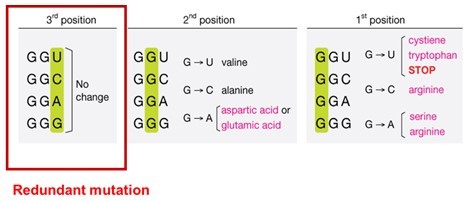
Try to answer the quiz below to check what you have learned so far about codons.
References
- Berg, J.M., Tymoczko, J.L., Stryer, L. (2002). Biochemistry. 5th edition. New York: Freeman, W. H. Section 5.5, Amino Acids Are Encoded by Groups of Three Bases Starting from a Fixed Point. Available from: https://www.ncbi.nlm.nih.gov/books/NBK22358/
- Lobanov, A. V., Turanov, A. A., Hatfield, D. L., & Gladyshev, V. N. (2010). Dual functions of codons in the genetic code. Critical reviews in biochemistry and molecular biology, 45(4), 257–265. https://doi.org/10.3109/10409231003786094
- Griffiths, AJ.F., Miller, J.H., Suzuki, D.T., et al. (2000). An Introduction to Genetic Analysis. 7th edition. New York: Freeman, W. H. Genetic code. Available from: https://www.ncbi.nlm.nih.gov/books/NBK21950/
- Koonin, E. V., & Novozhilov, A. S. (2009). Origin and evolution of the genetic code: the universal enigma. IUBMB life, 61(2), 99–111. https://doi.org/10.1002/iub.146
- Saier M. H., Jr (2019). Understanding the Genetic Code. Journal of bacteriology, 201(15), e00091-19. https://doi.org/10.1128/JB.00091-19
- Sleator R. D. (2014). The genetic code. Rewritten, revised, repurposed. Artificial DNA, PNA & XNA, 5(2), e29408. https://doi.org/10.4161/adna.294
©BiologyOnline.com. Content provided and moderated by Biology Online Editors.

